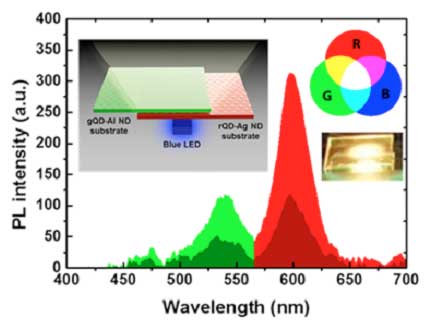| Posted: Jan 23, 2018 |
Highly efficient quantum dot LEDs with metallic nanostructures at low cost
(Nanowerk News) KAIST researchers have discovered a technology that enhances the efficiency of Quantum Dot LEDs (Small, "How Effective is Plasmonic Enhancement of Colloidal Quantum Dots for Color-Conversion Light-Emitting Devices?").
|
|
Professor Yong-Hoon Cho from the Department of Physics and his team succeeded in improving the efficiency of Quantum Dot (QD) Light-Emitting Diodes (LEDs) by designing metallic nanostructure substrates.
|
 |
| Spectrum showing different fluorescence with and without metallic nanostructure. (Image: KAIST)
|
|
QD LEDs possess very small semiconductor light sources and are considered to be the new rising technology for high performance full-color display. However, it is expensive to manufacture displays with QD LED only.
|
|
Existing QD-based displays use blue LEDs as a source of light, and they employ a method of color conversion through excitation of green and red QDs.
|
|
There are two inconveniences with the existing QD-based displays. As mentioned previously, QD LED is costly, hence the unit price of QD-based displays is higher. Also, the efficiency of a liquid type of QDs is drastically lowered after contact with air.
|
|
Professor Cho found the solution in a metallic nanostructure for lowering the production cost while improving the efficiency of QD LEDs.
|
|
The team exploited the phenomenon of so-called surface plasmonic resonances when nanoscale metallic structures are exposed to light. Depending on the metal, the size, and the shape, the properties of metallic structures vary.
|
|
The team used different metallic nanostructures for each QD LED – silver nanodisks for Red QDs and aluminum nanodisks for Green GDs – to make them more fluorescent.
|
|
With brighter QDs, it requires fewer QDs to manufacture QD LEDs, contributing to a lower unit price.
|
|
The team used silver and aluminum in this research, but metallic nanostructures can be redesigned according to the desired purposes.
|
|
Professor Cho said, “Implementing metallic nanostructures into QD LEDs in a proper manner can reduce the quantity of the QDs required for the system, leading to lower unit prices.”
|

